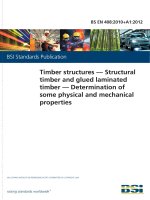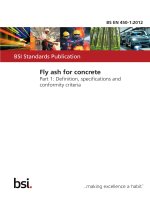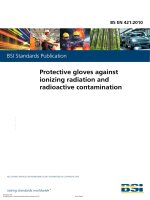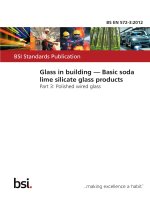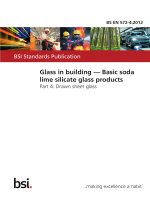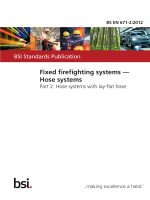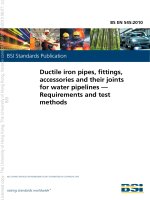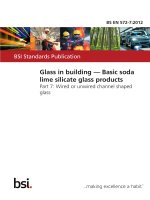Bsi bs en 61373 2010 (2012)
Bạn đang xem bản rút gọn của tài liệu. Xem và tải ngay bản đầy đủ của tài liệu tại đây (1.73 MB, 40 trang )
BS EN 61373:2010
Incorporating corrigenda October 2010, October 2011 and March 2012
BSI Standards Publication
Railway applications —
Rolling stock equipment —
Shock and vibration tests
BRITISH STANDARD
BS EN 61373:2010
National foreword
This British Standard is the UK implementation of EN 61373:2010. It is
identical to IEC 61373:2010, incorporating corrigendum October 2011. It
supersedes BS EN 61373:1999 which is withdrawn.
The start and finish of text introduced or altered by
corrigendum is indicated in the text by tags. Text altered by
IEC corrigendum October 2011 is indicated in the text by ˆ‰...
The UK participation in its preparation was entrusted by Technical Committee
GEL/9, Railway Electrotechnical Applications, to Subcommittee GEL/9/2,
Railway Electrotechnical Applications - Rolling stock.
A list of organizations represented on this committee can be obtained on
request to its secretary.
This publication does not purport to include all the necessary provisions of a
contract. Users are responsible for its correct application.
© The British Standards Institute 2012
ISBN 978 0 580 78603 7
ICS 17.160; 45.060.01
Compliance with a British Standard cannot confer immunity from
legal obligations.
This British Standard was published under the authority of the Standards
Policy and Strategy Committee on 31 October 2010.
Amendments/corrigenda issued since publication
Date
Text affected
31 October 2010
Correction to identifier in National foreword
31 January 2012
Implementation of IEC corrigendum October 2011
31 March 2012
Correction to running headers
EUROPEAN STANDARD
EN 61373
NORME EUROPÉENNE
EUROPÄISCHE NORM
September 2010
ICS 45.060
Supersedes EN 61373:1999
English version
Railway applications Rolling stock equipment Shock and vibration tests
(IEC 61373:2010)
Applications ferroviaires Matériel roulant Essais de chocs et vibrations
(CEI 61373:2010)
Bahnanwendungen –
Betriebsmittel von Bahnfahrzeugen –
Prüfungen für Schwingen und Schocken
(IEC 61373:2010)
This European Standard was approved by CENELEC on 2010-09-01. CENELEC members are bound to comply
with the CEN/CENELEC Internal Regulations which stipulate the conditions for giving this European Standard
the status of a national standard without any alteration.
Up-to-date lists and bibliographical references concerning such national standards may be obtained on
application to the Central Secretariat or to any CENELEC member.
This European Standard exists in three official versions (English, French, German). A version in any other
language made by translation under the responsibility of a CENELEC member into its own language and notified
to the Central Secretariat has the same status as the official versions.
CENELEC members are the national electrotechnical committees of Austria, Belgium, Bulgaria, Croatia, Cyprus,
the Czech Republic, Denmark, Estonia, Finland, France, Germany, Greece, Hungary, Iceland, Ireland, Italy,
Latvia, Lithuania, Luxembourg, Malta, the Netherlands, Norway, Poland, Portugal, Romania, Slovakia, Slovenia,
Spain, Sweden, Switzerland and the United Kingdom.
CENELEC
European Committee for Electrotechnical Standardization
Comité Européen de Normalisation Electrotechnique
Europäisches Komitee für Elektrotechnische Normung
Management Centre: Avenue Marnix 17, B - 1000 Brussels
© 2010 CENELEC -
All rights of exploitation in any form and by any means reserved worldwide for CENELEC members.
Ref. No. EN 61373:2010 E
BS EN 61373:2010
EN 61373:2010 (E)
-2-
Foreword
The text of document 9/1386/FDIS, future edition 2 of IEC 61373, prepared by IEC TC 9, Electrical
equipment and systems for railways, was submitted to the IEC-CENELEC parallel vote and was approved
by CENELEC as EN 61373 on 2010-09-01.
This European Standard supersedes EN 61373:1999.
The main technical changes with regard to the EN 61373:1999 are as follows:
– change of the method to calculate the acceleration ratio which has to be applied to the functional ASD
value to obtain the simulated long-life ASD value;
– addition of the notion of partially certified against this standard;
– suppression of Annex B of the EN 61373:1999 due to the new method to calculate the acceleration
ratio;
– addition of guidance for calculating the functional RMS value from service data or the RMS value from
ASD levels of Figures 2 to 5.
Attention is drawn to the possibility that some of the elements of this document may be the subject of
patent rights. CEN and CENELEC shall not be held responsible for identifying any or all such patent
rights.
The following dates were fixed:
– latest date by which the EN has to be implemented
at national level by publication of an identical
national standard or by endorsement
(dop)
2011-06-01
– latest date by which the national standards conflicting
with the EN have to be withdrawn
(dow)
2013-09-01
Annex ZA has been added by CENELEC.
__________
Endorsement notice
The text of the International Standard IEC 61373:2010 was approved by CENELEC as a European
Standard without any modification.
__________
BS EN 61373:2010
EN 61373:2010 (E)
-3-
Annex ZA
(normative)
Normative references to international publications
with their corresponding European publications
The following referenced documents are indispensable for the application of this document. For dated
references, only the edition cited applies. For undated references, the latest edition of the referenced
document (including any amendments) applies.
NOTE When an international publication has been modified by common modifications, indicated by (mod), the relevant EN/HD
applies.
Publication
Year
Title
EN/HD
Year
IEC 60068-2-27
2008
Environmental testing Part 2-27: Tests - Test Ea and guidance:
Shock
EN 60068-2-27
2009
IEC 60068-2-47
2005
Environmental testing EN 60068-2-47
Part 2-47: Tests - Mounting of specimens for
vibration, impact and similar dynamic tests
2005
IEC 60068-2-64
2008
Environmental testing Part 2-64: Tests - Test Fh: Vibration,
broadband random and guidance
EN 60068-2-64
2008
ISO 3534-1
2006
Statistics - Vocabulary and symbols Part 1: General statistical terms and terms
used in probability
-
-
BS EN 61373:2010
EN 61373:2010 (E)
This page deliberately left blank
–4–
BS EN 61373:2010
EN 61373:2010 (E)
CONTENTS
INTRODUCTION .....................................................................................................................6
1
Scope ...............................................................................................................................7
2
Normative references........................................................................................................8
3
Terms and definitions .......................................................................................................9
4
General .......................................................................................................................... 10
5
Order of testing............................................................................................................... 11
6
Reference information required by the test house ............................................................ 11
6.1
6.2
7
Method of mounting and orientation of equipment under test .................................. 11
Reference and check points................................................................................... 11
6.2.1 Fixing point ................................................................................................ 11
6.2.2 Check point ............................................................................................... 12
6.2.3 Reference point ......................................................................................... 12
6.2.4 Measuring point ......................................................................................... 12
6.3 Mechanical state and functioning during test .......................................................... 12
6.3.1 Mechanical state ........................................................................................ 12
6.3.2 Functional tests ......................................................................................... 13
6.3.3 Performance tests...................................................................................... 13
6.4 Reproducibility for random vibration tests ............................................................... 13
6.4.1 Acceleration spectral density (ASD) ........................................................... 13
6.4.2 Root mean square value (r.m.s.) ................................................................ 13
6.4.3 Probability density function (PDF) .............................................................. 13
6.4.4 Duration..................................................................................................... 13
6.5 Measuring tolerances............................................................................................. 14
6.6 Recovery ............................................................................................................... 14
Initial measurements and preconditioning........................................................................ 14
8
Functional random vibration test conditions ..................................................................... 14
9
8.1 Test severity and frequency range ......................................................................... 14
8.2 Duration of functional vibration tests ...................................................................... 15
8.3 Functioning during test .......................................................................................... 15
Simulated long-life testing at increased random vibration levels....................................... 15
9.1 Test severity and frequency range ......................................................................... 15
9.2 Duration of accelerated vibration tests ................................................................... 15
10 Shock testing conditions ................................................................................................. 16
10.1 Pulse shape and tolerance..................................................................................... 16
10.2 Velocity changes ................................................................................................... 16
10.3 Mounting ............................................................................................................... 16
10.4 Repetition rate ....................................................................................................... 16
10.5 Test severity, pulse shape and direction................................................................. 16
10.6 Number of shocks.................................................................................................. 17
10.7 Functioning during test .......................................................................................... 17
11 Transportation and handling............................................................................................ 17
12 Final measurements ....................................................................................................... 17
13 Acceptance criteria ......................................................................................................... 17
14 Report ............................................................................................................................ 17
BS EN 61373:2010
EN 61373:2010 (E)
–5–
15 Test certificate ................................................................................................................ 18
16 Disposal ......................................................................................................................... 18
Annex A (informative) Explanation of service measurements, measuring positions,
methods of recording service data, summary of service data, and method used to obtain
random test levels from acquired service data ....................................................................... 25
Annex B (informative) Figure identifying general location of equipment on railway
vehicles and their resulting test category ............................................................................... 32
Annex C (informative) Example of a type test certificate ....................................................... 33
Annex D (informative) Guidance for calculating RMS values from ASD values or levels......... 34
Figure 1 – Gaussian distribution ..............................................................................................9
Figure 2 – Category 1 – Class A – Body-mounted – ASD spectrum ........................................ 19
Figure 3 – Category 1 – Class B – Body-mounted – ASD spectrum ........................................ 20
Figure 4 – Category 2 – Bogie mounted – ASD spectrum ....................................................... 21
Figure 5 – Category 3 – Axle mounted – ASD spectrum ......................................................... 22
Figure 6 – Cumulative PDF tolerance bands .......................................................................... 23
Figure 7 – Shock test tolerance – Bands half sine pulse ........................................................ 24
Figure A.1 – Standard measuring positions used for axle, bogie (frame) and body ................. 25
Figure A.2 – Typical fatigue strength curve ............................................................................ 29
Figure B.1 – General location of equipment on vehicles ......................................................... 32
Figure D.1 – ASD spectrum ................................................................................................... 35
Table 1 – Test severity and frequency range for functional random vibration tests.................. 14
Table 2 – Test severity and frequency range.......................................................................... 15
Table 3 – Test severity, pulse shape and direction................................................................. 16
Table A.1 – Environment data acquisition summary of the test parameters/conditions ............ 26
Table A.2 – Summary of the r.m.s. acceleration levels obtained from the questionnaire ......... 28
Table A.3 – Test levels obtained from service data using the method shown in Clause A.4 .... 31
–6–
BS EN 61373:2010
EN 61373:2010 (E)
INTRODUCTION
This standard covers the requirements for random vibration and shock testing items of
pneumatic, electrical and electronic equipment/components (hereinafter only referred to as
equipment) to be fitted on to railway vehicles. Random vibration is the only method to be used
for equipment/component approval.
The tests contained within this standard are specifically aimed at demonstrating the ability of
the equipment under test to withstand the type of environmental vibration conditions normally
expected for railway vehicles. In order to achieve the best representation possible, the values
quoted in this standard have been derived from actual service measurements submitted by
various bodies from around the world.
This standard is not intended to cover self-induced vibrations as these will be specific to
particular applications.
Engineering judgement and experience is required in the execution and interpretation of this
standard.
This standard is suitable for design and validation purposes; however, it does not exclude the
use of other development tools (such as sine sweep), which may be used to ensure a
predetermined degree of mechanical and operational confidence. The test levels to be applied
to the equipment under test are dictated only by its location on the train (i.e. axle, bogie or
body-mounted).
It should be noted that these tests may be performed on prototypes in order to gain design
information about the product performance under random vibration. However, for test
certification purposes the tests have to be carried out on equipment taken from normal
production.
BS EN 61373:2010
EN 61373:2010 (E)
–7–
RAILWAY APPLICATIONS –
ROLLING STOCK EQUIPMENT –
SHOCK AND VIBRATION TESTS
1
Scope
This International Standard specifies the requirements for testing items of equipment intended
for use on railway vehicles which are subsequently subjected to vibrations and shock owing to
the nature of railway operational environment. To gain assurance that the quality of the
equipment is acceptable, it has to withstand tests of reasonable duration that simulate the
service conditions seen throughout its expected life.
Simulated long-life testing can be achieved in a number of ways each having their associated
advantages and disadvantages, the following being the most common:
a) amplification: where the amplitudes are increased and the time base decreased;
b) time compression: where the amplitude history is retained and the time base is decreased
(increase of the frequency);
c) decimation: where time slices of the historical data are removed when the amplitudes are
below a specified threshold value.
The amplification method as stated in a) above, is used in this standard and together with the
publications referred to in Clause 2; it defines the default test procedure to be followed when
vibration testing items for use on railway vehicles. However, other standards exist and may be
used with prior agreement between the manufacturer and the customer. In such cases test
certification against this standard will not apply. Where service information is available tests
can be performed using the method outlined in Annex A. If the levels are lower than those
quoted in this standard, equipment is partially certified against this standard (only for service
conditions giving functional test values lower than or equal to those specified in the test report).
Whilst this standard is primarily concerned with railway vehicles on fixed rail systems, its wider
use is not precluded. For systems operating on pneumatic tyres, or other transportation
systems such as trolleybuses, where the level of shock and vibration clearly differ from those
obtained on fixed rail systems, the supplier and customer can agree on the test levels at the
tender stage. It is recommended that the frequency spectra and the shock duration/amplitude
be determined using the guidelines in Annex A. Equipment tested at levels lower than those
quoted in this standard cannot be fully certified against the requirements of this standard.
An example of this is trolleybuses, whereby body-mounted trolleybus equipment could be
tested in accordance with category 1 equipment referred to in the standard.
This standard applies to single axis testing. However multi-axis testing may be used with prior
agreement between the manufacturer and the customer.
The test values quoted in this standard have been divided into three categories dependent only
upon the equipment’s location within the vehicle.
Category 1
Body mounted
Class A
Cubicles, subassemblies, equipment and components mounted directly on or
under the car body.
–8–
Class B
NOTE 1
BS EN 61373:2010
EN 61373:2010 (E)
Anything mounted inside an equipment case which is in turn mounted directly on
or under the car body.
Class B should be used when it is not clear where the equipment is to be located.
Category 2
Bogie mounted
Cubicles, subassemblies, equipment and components which are to be mounted on the bogie of
a railway vehicle.
Category 3
Axle mounted
Subassemblies, equipment and components or assemblies which are to be mounted on the
wheelset assembly of a railway vehicle.
NOTE 2 In the case of equipment mounted on vehicles with one level of suspension such as wagons and trucks,
unless otherwise agreed at the tender stage, axle mounted equipment will be tested as category 3, and all other
equipment will be tested as category 2.
The cost of testing is influenced by the weight, shape and complexity of the equipment under
test. Consequently at the tender stage the supplier may propose a more cost-effective method
of demonstrating compliance with the requirements of this standard. Where alternative
methods are agreed it will be the responsibility of the supplier to demonstrate to his customer
or his representative that the objective of this standard has been met. If an alternative method
of evaluation is agreed, then the equipment tested cannot be certified against the requirement
of this standard.
This standard is intended to evaluate equipment which is attached to the main structure of the
vehicle (and/or components mounted thereon). It is not intended to test equipment which forms
part of the main structure. Main structure in the sense of this standard means car body, bogie
and axle. There are a number of cases where additional or special vibration tests may be
requested by the customer, for example:
a) equipment mounted on, or linked to, items which are known to produce fixed frequency
excitation;
b) equipment such as traction motors, pantographs, shoegear, or suspension components
which may be subjected to tests in accordance with their special requirements, applicable
to their use on railway vehicles. In all such cases the tests carried out should be dealt with
by separate agreement at the tender stage;
c) equipment intended for use in special operational environments as specified by the
customer.
2
Normative references
The following referenced documents are indispensable for the application of this document. For
dated references, only the edition cited applies. For undated references, the latest edition of
the referenced document (including any amendments) applies.
IEC 60068-2-27:2008, Environmental testing – Part 2-27: Tests – Test Ea and guidance: Shock
IEC 60068-2-47:2005, Environmental testing – Part 2-47: Tests – Mounting of specimens for
vibration, impact and similar dynamic tests
IEC 60068-2-64:2008, Environmental testing – Part 2-64: Tests – Test Fh: Vibration,
broadband random and guidance
ISO 3534-1:2006, Statistics – Vocabulary and symbols – Part 1: Probability and general
statistical terms
BS EN 61373:2010
EN 61373:2010 (E)
3
–9–
Terms and definitions
For the purposes of this document, the terms and definitions given in IEC 60068-2-64 and in
ISO 3534-1 apply as well as the following.
3.1
random vibrations
a vibration the instantaneous value of which cannot be precisely predicted for any given instant
of time
3.2
Gaussian distribution ; normal distribution
a Gaussian, or normal, distribution has a probability density function equal to (see Figure 1):
Px ( x) =
1
σ 2. π
.
e
–( x – x )²
2 . σ²
where :
ˆσ
is the r.m.s value;‰
x is the instantaneous value;
x
is the mean value of
x.
ˆ
Px(x)
+3σ
+2σ
+1σ
x
x
0
x
t
–1σ
–2σ
–3σ
IEC 2338/11
‰
Figure 1 – Gaussian distribution
NOTE According to Figure 1, the probability that the instantaneous acceleration value is between ± a is equal to
the zone under the probability density curve P x(x). This means that the instantaneous acceleration value between:
•
0 and 1σ represents 68,26 % of the time,
•
1σ and 2σ represents 27,18 % of the time,
•
2σ and 3σ represents 4,30 % of the time.
3.3
Acceleration Spectral Density
ASD
mean-square value of that part of an acceleration signal passed by a narrow-band filter of a
centre frequency, per unit bandwith, in the limit as the bandwith approaches zero and the
averaging time approaches infinity
– 10 –
BS EN 61373:2010
EN 61373:2010 (E)
3.4
components
pneumatic, electrical, or electronic parts located inside a cubicle
3.5
cubicle
whole equipment, including mechanical parts and especially the structure, (e.g. converter,
inverter, etc.) composed of mounted components
4
General
This standard is intended to highlight any weakness/error which may result in problems as a
consequence of operation under environments where vibration and shock are known to occur
in service on a railway vehicle. This is not intended to represent a full life test. However, the
test conditions are sufficient to provide some reasonable degree of confidence that the
equipment will survive the specified life under service conditions.
Compliance with this standard is achieved if the criteria in Clause 13 are met.
The test levels quoted in this standard have been derived from environmental test data, as
referred to in Annex A. This information was submitted by organizations responsible for
collecting environmental vibration levels under service conditions.
The following tests are mandatory for compliance with this standard:
Functional random test
The functional ramdom test levels are the minimum test
levels to be applied in order to demonstrate that the
equipment under test is capable of functioning when
subjected to conditions which are likely to occur in service,
on railway vehicles.
The degree of functioning shall be agreed between the
manufacturer and the end user prior to tests commencing
(see 6.3.2). Functional test requirements are detailed in
Clause 8.
The functional tests are not intended to be a full performance evaluation under simulated service conditions.
Simulated long-life test
This test is aimed at establishing the mechanical integrity
of the equipment at increased service levels. It is not
necessary to demonstrate ability to function under these
conditions. Simulated long-life testing requirements are
detailed in Clause 9.
Shock testing
Shock testing is aimed at simulating rare service events. It
is not necessary to demonstrate functionality during this
test. It will however be necessary to demonstrate that no
change in operational state occurs, that there is no visual
deformation and that mechanical integrity has not
changed. These points shall be clearly demonstrated in
the final test report. Shock testing requirements are
detailed in Clause 10.
BS EN 61373:2010
EN 61373:2010 (E)
5
– 11 –
Order of testing
A possible order of testing is as follows:
Vertical, transverse and longitudinal simulated long-life testing by increased random vibration;
followed by vertical, transverse and longitudinal shock testing; followed by transportation and
handling (when identified/agreed) and finally by vertical, transverse and longitudinal functional
random testing.
NOTE Transportation and handling tests are not a requirement of this standard, and are therefore not included in
this standard.
The order of testing may be altered to minimize re-jigging. The order of testing shall be
recorded in the report. Performance tests in accordance with 6.3.3 shall be undertaken before
and after simulated long-life testing, during which time transfer functions shall be taken for
comparison purposes in order to establish if any changes have taken place as a result of the
simulated long-life testing.
The orientation and direction of excitation shall be stated in the test specification and included
in the report.
6
Reference information required by the test house
NOTE 1
Additional general information can be found in IEC 60068-2-64.
NOTE 2
For general mounting of components refer to IEC 60068-2-47.
6.1
Method of mounting and orientation of equipment under test
The equipment under test shall be mechanically connected to the test machine by its normal
devices of attachment, including any resilient mount, either directly or by utilising a fixture.
As the method of mounting can significantly influence the results obtained, the actual method
of mounting shall be clearly identified in the test report.
Unless otherwise agreed it is preferred that the equipment shall be tested in its normal working
orientation with no special precautions taken against the effects of magnetic interference, heat
or any other factors upon the operation and performance of the equipment under test.
Wherever possible, the fixture shall not have a resonance within the test frequency range.
When resonances are unavoidable, the influence of the resonance on the performance of the
equipment under test shall be studied and identified in the report.
6.2
Reference and check points
The test requirements are confirmed by measurements made at a reference point and, in
certain cases, at check points, related to the fixing points of the equipment.
In the case of large numbers of small items of equipment mounted on one fixture, the
reference and/or check points may be related to the fixture rather than to the fixing points of
the equipment under test, provided the lowest resonant frequency of the loaded fixture is
higher than the upper test frequency limit.
6.2.1
Fixing point
A fixing point is a part of the equipment under test in contact with the fixture or vibration testing
surface at a point where the equipment is normally fastened in service.
– 12 –
6.2.2
BS EN 61373:2010
EN 61373:2010 (E)
Check point
A check point shall be as close as possible to a fixing point and in any case shall be rigidly
connected to it. If four or less fixing points exist, each one is defined as a check point. The
vibration at these points shall not fall below the specified minimum limits. All check points shall
be identified in the test report. In the case of small items of equipment where the size, weight
and complexity of the mechanical structure do not merit multipoint checking, the report shall
identify how many check points were used and their locations.
6.2.3
Reference point
The reference point is the single point from which the reference signal is obtained in order to
confirm the test requirements, and is taken to represent the motion of the equipment under
test. It may be a check point or a fictitious point created by manual or automatic processing of
the signals from the check points.
For random vibration if a fictitious point is used, the spectrum of the reference signal is defined
as the arithmetic mean at each frequency of the acceleration spectral density (ASD) values of
the signals from all check points. In this case, the total r.m.s. value of the reference signal is
equivalent to the root mean square of the r.m.s. values of the signals from the check points.
Total r.m.s. value of the reference point =
where
Σ ii ==1nc (r . m. s. i ) 2
nc
nc is the number of check points.
The report shall state the point used and how it was chosen. It is recommended that for large
and/or complex equipment a fictitious point is used.
NOTE Automatic processing of the signals from the check points using a scanning technique to create the
fictitious point is permitted for confirmation of the total r.m.s. acceleration. However, it is not permitted for
confirmation of the ASD level without correcting for such sources of error as analyzer bandwidth, sampling time,
etc.
6.2.4
Measuring point
A measuring point is a specific location on the equipment under test at which data is gathered
for the purpose of examining the vibration response characteristics of the equipment. A
measuring point is defined before commencing the tests detailed in this standard (see
Clause 7).
6.3
6.3.1
Mechanical state and functioning during test
Mechanical state
If the equipment under test has more than one mechanical condition in which it could remain
for long periods when fitted to a railway vehicle, two mechanical states shall be selected for
test purposes. At least one of the worst states shall be selected (for example, in the case of a
contactor, the mechanical state which affords the least clamping pressure).
When more than one state exists, the equipment under test shall spend equal time in both
states selected during vibration and shock testing, the levels of which are as specified in
Clauses 8, 9 and 10.
BS EN 61373:2010
EN 61373:2010 (E)
6.3.2
– 13 –
Functional tests
If required, the functional tests shall be specified by the manufacturer and agreed between
manufacturer and customer prior to commencement of the tests. They shall be carried out
during the vibration tests at the levels stated in Clause 8 of this standard.
Functional tests are aimed at verifying the operational capability and are not to be confused
with performance tests. They are only intended to demonstrate a degree of confidence that the
equipment under test will perform in service.
NOTE 1 Functional tests will not be conducted during shock testing unless previously agreed between the
manufacturer and end user.
NOTE 2
6.3.3
In the case where the functional tests are modified, this has to be detailed in the report.
Performance tests
Performance tests shall be carried out prior to commencement, and upon completion of all the
tests specified. The performance test specification shall be defined by the manufacturer and
shall include tolerance limits.
6.4
Reproducibility for random vibration tests
Random vibration signals are not repeatable in the time domain; no two similar length time
samples from a random signal generator can be overlaid and shown to be identical.
Nevertheless it is possible to make statements about the similarity of two random signals and
set tolerance bands on their characteristics. It is necessary to define a random signal in a way
which ensures that should the test be repeated at a later date, by a different test house or on a
different item of equipment, the excitation is of a similar severity. It should be noted that all the
following tolerance boundaries include instrumentation errors but exclude other errors,
specifically random (statistical) errors and bias errors. The measurements are taken at the
check/reference point(s).
6.4.1
Acceleration spectral density (ASD)
The ASD shall be within 3 dB (range ẵ ì ASD to 2 × ASD) of the specified ASD levels as
shown in the appropriate Figures 2 to 5. The initial and final slope should not be less than
those shown in Figures 2 to 5.
6.4.2
Root mean square value (r.m.s.)
The r.m.s. of the acceleration at the reference point over the defined frequency range shall be
that specified in Figures 2 to 5 ± 10 %.
NOTE With respect to the low frequency content it may be difficult to obtain ±3 dB. In such cases it is only
important for the test value to be noted in the report.
6.4.3
Probability density function (PDF)
Unless otherwise stated, for each measuring point the time series of the measured
acceleration(s) shall have a distribution with a PDF which is approximately Gaussian and a
crest factor (ratio of the peak to r.m.s. values) of at least 2,5.
NOTE
6.4.4
Figure 6 shows the tolerance bands of the cumulative PDF.
Duration
The total duration of exposure to the prescribed random vibration in each axis shall not be less
than that specified (see 8.2 and 9.2).
BS EN 61373:2010
EN 61373:2010 (E)
– 14 –
6.5
Measuring tolerances
The vibration tolerances ˆshall conform to 4.2, 4.3, and 4.6 of IEC 60068-2-64.‰
6.6
Recovery
The initial and final measurements shall be taken under the same conditions (for example,
temperature). In order to enable the equipment under test to attain the same conditions as
existed for the initial measurements, (if necessary) a period for recovery shall be allowed after
testing and before the final measurements are made.
7
Initial measurements and preconditioning
Before commencing any testing, the equipment shall be subjected to a performance test
according to 6.3.3. Where the nature of such testing is outside the physical capability of the
test house, the tests shall be conducted by the manufacturer who shall provide a statement
that the item under test conformed with the performance tests prior to the vibration and shock
testing identified in this standard. It is the responsibility of the manufacturer to define the
location of the measuring points which shall be clearly identified in the report.
Transfer functions shall be calculated from the random signals taken from the reference point
and measuring points, which shall be defined by the manufacturer. Where panels are removed
for examination or instrumentation, they shall be replaced during the testing.
The transfer functions shall be taken under the test conditions specified in Clause 8 for
categories 2 and 3 equipment and in Clause 9 for category 1 equipment.
The measurement shall aim to achieve a coherence of at least 0,9. If this is not possible, a
minimum of 120 spectral averages (or 240 statistical degrees of freedom for linear averaging)
shall be taken with 0 % overlap.
8
Functional random vibration test conditions
8.1
Test severity and frequency range
The equipment shall be tested with the relevant r.m.s. value and frequency range given in
Table 1. When the orientation at which the equipment will be installed is unclear or unknown,
the test shall be carried out in the three axes with the r.m.s. value given for the vertical axis.
Table 1 – Test severity and frequency range
for functional random vibration tests
Category
Orientation
RMS
Frequency range
m/s 2
Vertical
0,750
Class A
Transverse
0,370
Body mounted
Longitudinal
0,500
1
Vertical
1,01
Class B
Transverse
0,450
Body mounted
Longitudinal
0,700
Vertical
5,40
Transverse
4,70
Longitudinal
2,50
Vertical
38,0
Transverse
34,0
Longitudinal
17,0
1
2
Bogie mounted
3
Axle mounted
NOTE 1
Figure 2
Figure 3
Figure 4
Figure 5
These test values are intended to represent typical service values as highlighted in Annex A, and are the
BS EN 61373:2010
EN 61373:2010 (E)
– 15 –
minimum test levels to be applied to the equipment under test for a full certification. Where actual measured data
exists the functional vibration test conditions listed above may be increased by using the method shown in Annex A
and the equations shown in Annex D.
NOTE 2 By using the method shown in Annex A and the equations shown in Annex D, actual measured data may
conduce to functional test values lower than the minimum test levels quoted in Table 1. These low functional test
values may be applied to the equipment under test with prior agreement between the manufacturer and the
customer. In such case the equipment tested cannot be fully certified against the requirements of this standard.
The equipment tested is partially certified (only validated for service conditions giving functional test values lower
than or equal to those specified in the test report).
8.2
Duration of functional vibration tests
NOTE 1 The object of this test is to demonstrate that the equipment under test is unaffected by the applied test
levels which are representative of those expected in service.
NOTE 2
It is envisaged that these tests would not normally take less than 10 min.
The duration of the functional vibration test shall be sufficient to allow all the specified
functions to be completed.
8.3
Functioning during test
The functional tests agreed with the customer (see 6.3.2) shall be carried out during functional
random vibration testing.
9
9.1
Simulated long-life testing at increased random vibration levels
Test severity and frequency range
When the orientation at which the equipment will be installed is unclear or unknown, the
equipment shall be subjected to the vertical test levels of Table 2 in all three axes.
Table 2 – Test severity and frequency range
Category
Orientation
RMS
Frequency range
5 h test period
m/s 2
1
Vertical
4,25
Class A
Transverse
2,09
Body mounted
Longitudinal
2,83
1
Vertical
5,72
Class B
Transverse
2,55
Body mounted
Longitudinal
3,96
2
Vertical
30,6
Bogie mounted
Transverse
26,6
Longitudinal
14,2
3
Vertical
144
Axle mounted
Transverse
129
Longitudinal
64,3
Figure 2
Figure 3
Figure 4
Figure 5
NOTE If the functional test values are issued from actual measured data, the long life test values are obtained by
using the acceleration ratio calculated in Annex A.
9.2
Duration of accelerated vibration tests
All categories of equipment shall be subjected to a total conditioning time of 15 h. This shall
normally be divided into periods of 5 h conditioning in each of three mutually perpendicular
axes. If during the course of testing overheating of equipment is felt to be a problem, (i.e.
vibration of rubber parts, etc.) it is permissible to stop the tests for a period of time in order to
allow the equipment to recover. However, it must be noted that the total duration of 5 h
vibration shall be achieved. If tests are stopped then this shall be stated in the report.
BS EN 61373:2010
EN 61373:2010 (E)
– 16 –
NOTE 1
It is not necessary for equipment to function during this test.
NOTE 2 It is possible by prior agreement to reduce the amplitude of vibration. However, it is essential that the
duration of the test period be increased in accordance with the method shown in Annex A. This is not a preferred
option and should be limited to category 3 axle mounted equipment.
10 Shock testing conditions
10.1
Pulse shape and tolerance
The equipment under test shall be subjected to a sequence of single half sine pulses each with
a nominal duration of D and a nominal peak amplitude of A conforming to IEC 60068-2-27 (see
Figure 7 for values of D and A).
The transverse acceleration shall not exceed 30 % of the peak acceleration of the nominal
pulse in the intended direction in accordance with IEC 60068-2-27.
Figure 7 shows pulse shape and tolerance limits.
10.2
Velocity changes
The actual velocity change shall be within ±15 % of the value corresponding to the nominal
pulse shown in Figure 7.
Where the velocity change is determined by integration of the actual pulse shown, it shall be
evaluated over the integration time interval shown in Figure 7.
10.3
Mounting
The equipment under test shall be connected to the test machine in accordance with 6.1.
10.4
Repetition rate
In order to allow the equipment under test to recover from any resonance effects sufficient time
shall be allowed to elapse between the application of shocks.
10.5
Test severity, pulse shape and direction
Values are given in Table 3.
Table 3 – Test severity, pulse shape and direction
Category
Orientation
Peak acceleration A
Nominal duration D
m/s 2
ms
1
Vertical
30
30
Class A and class B
Transverse
30
30
Body mounted
Longitudinal
50
30
All
300
18
All
1 000
6
2
Bogie mounted
3
Axle mounted
NOTE 1
See Figure 7 for pulse shape details.
NOTE 2 The heavy equipment, for which there is not test bench sufficiently sized to carry out the shock tests,
will be the subject of appropriate test conditions (reduction of the acceleration peak values), by prior agreement
between the manufacturer and the customer.
BS EN 61373:2010
EN 61373:2010 (E)
10.6
– 17 –
Number of shocks
18 shocks (three positive and three negative in each of the three orthogonal axes) as specified
in IEC 60068-2-27 shall be applied to the equipment. This test shall be repeated for each
mechanical state as identified in 6.3.1.
10.7
Functioning during test
It is not necessary for the equipment to operate during tests. Nevertheless some equipment
may have to retain its functional integrity; this shall be verified as requested by the
manufacturer or the customer in the test specification unless otherwise stated in the relevant
product standard.
11 Transportation and handling
Where transportation and handling tests are specifically requested by the end user, they shall
be in accordance with IEC 60068-2-27.
12 Final measurements
On completion of the tests, the equipment shall be subjected to a performance test according
to 6.3.3. Owing to the nature of such testing, it may be outside the capability of the test house.
In such cases, the tests will be conducted by the manufacturer who shall provide a statement
that the item under test conformed with the performance tests after the vibration and shock
testing identified in this standard.
Transfer functions shall be calculated from the random signals taken from the reference point
and measuring points, which shall be defined by the manufacturer. Where panels are removed
for examination or instrumentation, they shall be replaced during the testing.
The transfer functions shall be taken under the test conditions specified in Clause 8 for
categories 2 and 3 equipment and in Clause 9 for category 1 equipment.
The measurement shall aim to achieve a coherence of at least 0,9. If this is not possible a
minimum of 120 spectral averages (or 240 statistical degrees of freedom for linear averaging)
with 0 % overlap, shall be taken.
Any changes in the transfer functions or other measurements shall be investigated and
explained in the test report.
13 Acceptance criteria
On successful completion of all of the following tests, the equipment shall be considered
suitable for test certification:
a) performance according to 6.3.3 remains within the defined limits;
b) function according to 6.3.2 remains within the defined limits;
c) no visual deformation and mechanical integrity has not changed.
Engineering judgment is required.
14 Report
Upon completion of all or part of the tests, final measurements and functional checks, the test
house shall issue a comprehensive report to their customer. The report shall describe the
execution of the tests and their effect on the equipment together with:
– 18 –
BS EN 61373:2010
EN 61373:2010 (E)
a) the summary which shall identify changes which have occurred during the tests. Serial
numbers/identification shall be quoted;
b) details of the instrumentation and test procedures used, which shall be made available on
request. They may be included in the report but this is not mandatory;
c) methods of mounting which shall be reported as identified in 6.1;
d) method and order of testing used. The report shall also include figures showing the location
of all checking and measuring positions;
e) functional tests carried out and values obtained pre-test and post-test;
f)
results of tests from check and reference positions, together with observations against the
set objectives and acceptance criteria. The report shall contain all the check point graphs
which shall be in the format of Figures 2 to 7. They shall also contain the tolerance bands in
order to demonstrate that the tests remained within the tolerance limits stated in this
standard;
g) all observations done when functional test during vibration and/or function verification
during shock are required.
NOTE Where special tests have been carried out which exceed the requirements of this standard they may be
included in the report.
15 Test certificate
Test certificate shall include all of the following information:
–
description of equipment tested;
–
manufacturer’s name;
–
equipment type and issue/modification status;
–
equipment serial number;
–
test house report number;
–
report date;
–
product test specification.
This certificate shall be signed by authorised representatives of the test house and the
manufacturer.
NOTE
An example of a typical type test certificate is shown in Annex C.
16 Disposal
The equipment, having satisfied the test objectives and acceptance criteria, may be
refurbished to a standard agreed between the manufacturer and the end user, and placed in
operational service.
For traceability purposes, it is the responsibility of the manufacturer to identify clearly all items
which have been tested in accordance with this standard.
BS EN 61373:2010
EN 61373:2010 (E)
– 19 –
2 2
ASD (m/s ) /Hz
(log scale)
9 dB/octave
Tolerance bands ±3 dB
on nominal spectrum
Upper limit
Normal
X
–6 dB/octave
Lower limit
f1
5
f2
20
Frequency Hz
(log scale)
IEC 1100/10
when mass
≤500 kg:
f 1 = 5 Hz
when mass
>500 kg≤1 250 kg:
f1 =
when mass
>1 250 kg:
f 1 = 2 Hz
f 2 = 150 Hz
1 250
× 2 Hz
mass
f2 =
1 250
× 60 Hz
mass
f 2 = 60 Hz
Vertical
Transverse
Longitudinal
Functional test
ASD level
(m/s 2 ) 2 /Hz
0,0166
0,0041
0,0073
RMS value m/s 2
2 Hz to 150 Hz
0,750
0,370
0,500
Long-life test
ASD level
(m/s 2 ) 2 /Hz
0,532
0,131
0,234
RMS value m/s 2
2 Hz to 150 Hz
4,25
2,09
2,83
NOTE 1
For items with test frequencies over than 2 Hz the r.m.s. levels shall be lower than those quoted above.
NOTE 2
above.
For items with test frequencies less than 150 Hz the r.m.s. levels shall be lower than those quoted
NOTE 3 If frequencies above f 2 are known to exist they may be included, the amplitude being established by
extending the 6 dB/octave decay line until it intersects the maximum frequency required. In such cases the r.m.s.
levels shall be increased.
Figure 2 – Category 1 – Class A – Body-mounted – ASD spectrum
BS EN 61373:2010
EN 61373:2010 (E)
– 20 –
2 2
ASD (m/s ) /Hz
(log scale)
9 dB/octave
Tolerance bands ±3 dB
on nominal spectrum
Upper limit
Normal
X
–6 dB/octave
Lower limit
f1
5
f2
20
Frequency Hz
(log scale)
IEC 1101/10
when mass
≤500 kg:
f 1 = 5 Hz
when mass
>500 kg≤1 250 kg:
f1 =
when mass
>1 250 kg:
f 1 = 2 Hz
Functional test
f 2 = 150 Hz
1 250
× 2 Hz
mass
f2 =
1 250
× 60 Hz
mass
f 2 = 60 Hz
Vertical
Transverse
Longitudinal
0,0301
0,0060
0,0144
1,01
0,450
0,700
0,964
0,192
0,461
5,72
2,55
3,96
ASD level
(m/s 2 ) 2 /Hz
RMS value m/s 2
2 Hz to 150 Hz
Long-life test
ASD level
(m/s 2 ) 2 /Hz
RMS value m/s 2
2 Hz to 150 Hz
NOTE 1
For items with test frequencies over than 2 Hz the r.m.s. levels shall be lower than those quoted above.
NOTE 2
above.
For items with test frequencies less than 150 Hz the r.m.s. levels shall be lower than those quoted
NOTE 3 If frequencies above f 2 are known to exist they may be included, the amplitude being established by
extending the 6 dB/octave decay line until it intersects the maximum frequency required. In such cases the r.m.s.
levels shall be increased.
Figure 3 – Category 1 – Class B – Body-mounted – ASD spectrum
BS EN 61373:2010
EN 61373:2010 (E)
– 21 –
2 2
ASD (m/s ) /Hz
(log scale)
9 dB/octave
Tolerance bands ±3 dB
on nominal spectrum
Upper limit
Normal
X
–6 dB/octave
Lower limit
f1
10
f2
100
Frequency Hz
(log scale)
IEC 1102/10
when mass
≤100 kg:
f 1 = 5 Hz
when mass
>100 kg≤250 kg:
f1 =
when mass
>250 kg:
f 1 = 2 Hz
Functional test
f 2 = 250 Hz
250
× 2 Hz
mass
f2 =
250
× 100 Hz
mass
f 2 = 100 Hz
Vertical
Transverse
Longitudinal
0,190
0,144
0,0414
5,40
4,70
2,50
6,12
4,62
1,32
30,6
26,6
14,2
ASD level
(m/s 2 ) 2 /Hz
RMS value m/s 2
2 Hz to 250 Hz
Long-life test
ASD level
(m/s 2 ) 2 /Hz
RMS value m/s 2
2 Hz to 250 Hz
NOTE 1
For items with test frequencies over than 2 Hz the r.m.s. levels shall be lower than those quoted above.
NOTE 2
above.
For items with test frequencies less than 250 Hz the r.m.s. levels shall be lower than those quoted
NOTE 3 If frequencies above f 2 are known to exist they may be included, the amplitude being established by
extending the 6 dB/octave decay line until it intersects the maximum frequency required. In such cases the r.m.s.
levels shall be increased.
Figure 4 – Category 2 – Bogie mounted – ASD spectrum
BS EN 61373:2010
EN 61373:2010 (E)
– 22 –
2 2
ASD (m/s ) /Hz
(log scale)
9 dB/octave
Tolerance bands ±3 dB
on nominal spectrum
Upper limit
Normal
X
–6 dB/octave
Lower limit
10
20
100
f2
Frequency Hz
(log scale)
IEC 1103/10
when mass
≤50 kg:
f 2 = 500 Hz
when mass
>50 kg≤125 kg:
f2 =
when mass
>125 kg:
f 2 = 200 Hz
Functional test
125
× 200 Hz
mass
Vertical
Transverse
Longitudinal
8,74
7,0
1,751
38,0
34,0
17,0
124,9
100,2
25,02
144
129
64,3
ASD level
(m/s 2 ) 2/ Hz
RMS value m/s 2
10 Hz to 500 Hz
Long-life test
ASD level
(m/s 2 ) 2 /Hz
RMS value m/s 2
10 Hz to 500 Hz
NOTE 1
above.
For items with test frequencies less than 500 Hz the r.m.s. levels shall be lower than those quoted
NOTE 2 If frequencies above f 2 are known to exist they may be included, the amplitude being established by
extending the 6 dB/octave decay line until it intersects the maximum frequency required. In such cases the r.m.s.
levels shall be increased.
Figure 5 – Category 3 – Axle mounted – ASD spectrum
